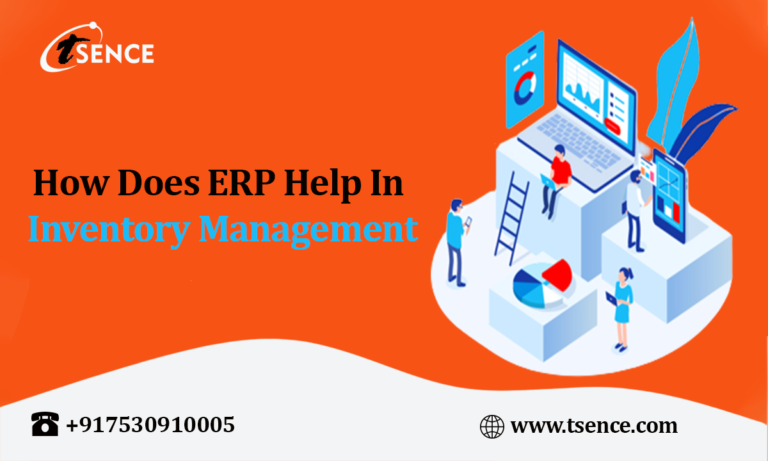Enterprise resource planning software makes a purchase, selling, accounting, production, supply chain plan, inventory, and all other business operations simple and stress-free.
Let’s understand how a TSENCE solution helps you improve inventory visibility.
Inventory visibility is one of the significant features of any manufacturing business. It helps organizations understand how much inventory is easily reached, at what location, and at any particular point in time. To ensure inventory visibility, you should have access to view, control, and update your inventory position from trusted software.
Today, numerous small to mid-sized businesses depend on business management software to complete things, from invoicing to accounting to stock levels to client management. ERP brings all these arrangements into one application, and in this manner brings all data into one middle hub. This implies that an update in sales, for instance, will also change inventory, order management, and financial management. ERP Software allows all region of your business to converse, relate, and integrate all into one exclusive solution, which can potentially improve the overall operations enormously.
How ERP Systems Help Inventory Management
As a custom manufacturer, using the ERP System for inventory management is one of the smartest choices that you can build. Not only will you keep away from the drawback of using a worksheet. And the entire person’s fault can be associated with that, for instance, mislaid or wrong information. But it can also save you the time exhausted in physically updating as well as balancing inventory.
By using an ERP system your inventory will regularly be included with all features of your process from planning during operations, production, and accounting. You will be able to run your complete process from one scheme and create your business more organized, smooth, and competent.
No two ERPs are similar; however, the list management element within an ERP will frequently contain the next features: Stock tracking & management.
- Sales & Purchase Order Management
- Multi-Channel Order Completion
- Storage Management & Stock Transfer
- Payment Gateway Functionality
- Integrations With Ecommerce, Accounting, Shipping & Other Prepared Tools
- Intelligence Reports & Analytics
Benefits of ERP Inventory Management
#1: Resolve Changeable Scenario
ERP promotes automatic processes and incorporates production functionality. It synchronizes production, sales, financial management, and warehouse management as well as automatically tracks the movement of every supply item.
#2: ERP Systems Save Your Money
Every business owner knows that efficiency equals cost savings. Rather than paying for a separate system to switch different parts of your business, using an ERP for inventory management handle several different aspects of your business, reducing general workload & minimizing operating cost.
ERP inventory management systems are intended to reduce manual labor, by automating and streamlining procedures – all of which go hand-in-hand with raising a business. And ERP systems allow you to collect better worth data, which gives you insight into your business to help you to follow your business routine as well as plan for growth.
#3: Better Supply Levels and Better Custom Relationships
Get close to point-of-sole online business, shipping data, procurement, and production data, all on a single display. This allows a data-led executive who nurture relations with customers and vendors. With real-time dashboards, businesses can view inventory status at dissimilar plant locations, warehouses, stores, etc.
ERP gives you the functionality to check trends to ensure you gather customer orders on time. This develops a dependable client base which increase support and profitability.
#4: Streamline The Business Process
Exact inventory management can assist increase a manufacturer’s overall efficiency. Employees can invest their time on other tasks rather than for example trying to locate one specific piece of stock. With an ERP system, you can therefore monitor the stock you use one each work, which for instance, will let you do proper production planning as you know exactly the amount of raw material you have on-hand, & you have to request to finish a work.
#5: Forecasting, Restock, & Managing Excess Inventory
The ERP system keeps track of sales, purchasing, and logistics for you therefore that you can have the correct stock levels to coordinate your business requirements.
With an ERP you can take benefit of an inventory management system that is in sync with the remainder of your activity, which makes it easier for you to manage things. Such as long lead-items, as you can know these items during the design phase of a project. And have more lead time to arrange the thing and make sure you have it as expected.
Realizing real-time stock levels additionally makes it simpler to recharge stock – an ERP can also naturally reorder materials for you. Or send your purchasing manager a timely reminder letting her know that items require to be reordered. Without an ERP telling you that it’s time to renovate stock, manufacturers can confront enormous costs to make easy cargo when they are greatly in need of stock.
TSENCE provides the best Enterprise Resource Planning Services in Noida for the manufacturing industry all over India; to schedule a free demo, Get In Touch with our team info@tsence.com




